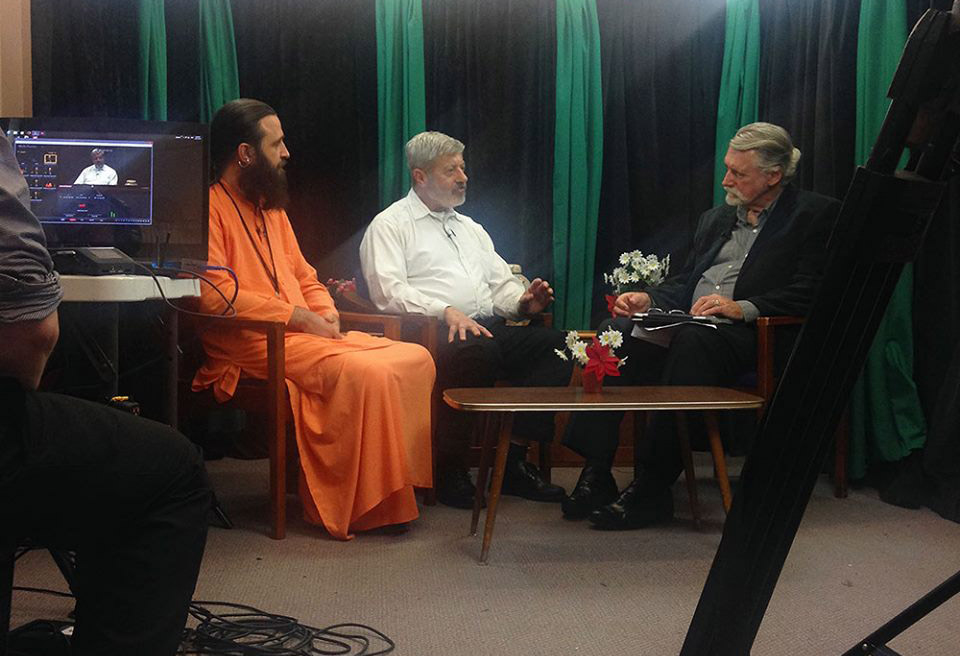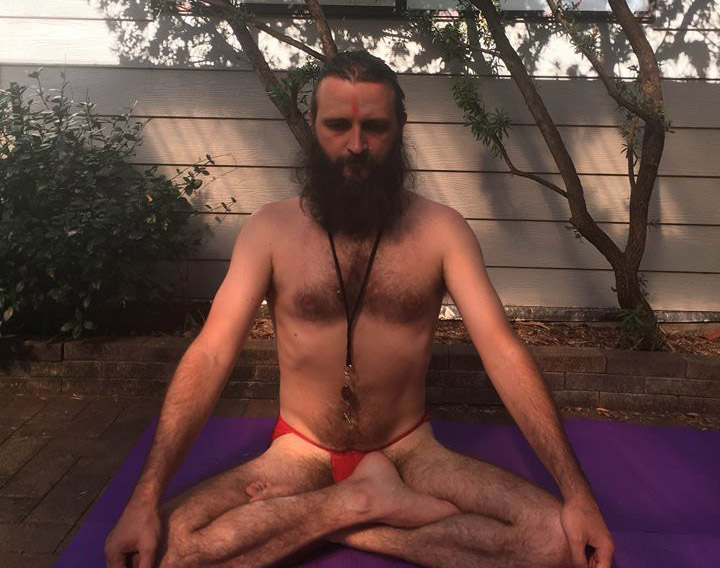Tantrāloka chapter 5 śloka 71
Summary of discussion on Tantrāloka made by Guru Yogi Matsyendranath and Rev. John Dupuche
The verse reads as follows:
“Let the wise man come to the ‘heart’: when the śakti is aroused, when he enters into the kula, when he is aware of the extremities of all the channels, when there is omnipresence, when everything is drawn into the Self.”
śākte kṣobhe kulāveśe sarvanāḍyagragocare |
vyāptau sarvātmasaṁkoce hṛdayaṁ praviśetsudhīḥ ||
TĀ 5:71
This śloka lists a range of different contexts of pleasure and concludes by noting that that the wise person (sudhīḥ) will, in all these various contexts, arrive (praviśet) at the principle that unites them all, which is the heart (hṛdayaṁ).
The contexts proceed from the outer and most visible to the most interior and unperceived. This is in keeping with the general principle that the inner is superior to the outer, the universal to the particular, the unexpressed to the expressed; the inner is the source of the outer; the purpose of the outer is to reach the inner.
The list goes, by stages from the individual ‘external śakti’ to the sense of universal presence and ultimately to the ‘self’. These are put in sequence to show that one leads to the other, for when there is sexual union, either actual or remembered, then all the faculties are heightened, every sensation is awakened, and one acquires a sense of universality and of the Self. The list is thus read as a sequence, a series of consequences, a progression.
The list can also be read as a set of alternatives: the actual intercourse, the memory of it, the awakening of any faculty, the sense of universal pervasion, the focus on the self etc. Any of these methods will lead to the heart. This idea is found also in the Vijñānabhairava-tantra, which consists of 112 methods of which only two are clearly sexual. These two are quoted in Jayaratha’s commentary on TĀ 5:71.
Jayaratha’s commentary:
Jayaratha prepares the reader for TĀ 5:71 by making two comments. First he notes that the ‘individual means’ (āṇavopāya), which is the subject matter of Tantrāloka chapter 5, is a practice (sādhanatva) concerned with pleasant things (sukha). He then goes on to say that pleasure has a host of disparate (bhagna) forms. How then can the practitioner maintain a sense of unity or single-mindedness (ekaka)? The question is valid. Given the multiplicity of forms of pleasure is there not a risk of the practitioner’s mind being dissipated? Will he not become so distracted by one delight after another that he becomes disjointed?
To answer this question Jayaratha takes each of the different contexts of TĀ 5:71 and supplies a śloka from the Vijñānabhairava-tantra as an illustration.
śākte kṣobhe
Jayaratha specifies that śākte kṣobhe refers to the enjoyment of the ‘external śakti’ (bāhyaśaktisaṃbhoge), namely the act of intercourse. In illustration he quotes Vijñānabhairava-tantra 69, which we have studied elsewhere in detail.
“He comes to the śakti; the śakti is fully aroused; he enters into the śakti; the climax occurs: – the pleasure [experienced at that point] is ‘Brahma’; that pleasure is his very own.”
शक्तिसङ्गमसङ्क्षुब्धशक्त्यावेशावसानिकम्।
यत्सुखम् ब्रह्मतत्त्वस्य तत्सुखं स्वाक्यम् उच्यते॥ ६९॥
śaktisaṃgamasaṃkṣubdhaśaktyāveśāvasānikam |
yat sukham brahmatattvasya tat sukhaṃ svākyam[1] ucyate || 69 ||
The phrase śākte kṣobhe is echoed in śakti-saṃgama-saṃkṣubdha of 69: ‘the śakti is fully aroused’. This phrase, śākta kṣobhe, is further investigated in the following śloka at TĀ 5:72 where Jayaratha asks what is the meaning of śāktasya kṣobhasya and makes it clear that it refers to sexual union.
kulāveśe
TĀ 5:71 broadens the area of awareness, from the individual woman to the realm of the feminine. The term kula can refer to Śakti and is contrasted with Akula, which refers to Śiva, but it can also have a wider reference, namely all the outpourings of Śakti who is the source of the universe.
Jayaratha quotes Vijñānabhairava-tantra 70, which speaks of the memory of a past encounter and all that happened. We have already studied it elsewhere in detail.
“O Mistress of the Gods, bliss surges even in the absence of a śakti, through the act of recalling intently the pleasure experienced with a woman, the kissing, the embracing, the clasping.”
लेहनामन्थनाकोटैः स्त्रीसुखस्य भरात्स्मृतेः।
शक्त्यभावेऽपि देवेशि भवेद् आनन्दसम्प्लवः॥ ७०॥
lehanāmanthanākoṭaiḥ strīsukhasya bharāt smṛteḥ |
śaktyabhāve ‘pi deveśi bhaved ānandasamplavaḥ || 70 ||
sarvanāḍyagragocare
TĀ 5:71 expands the realm of awareness.
Jayaratha gives two interpretations at this point. First of all he interprets sarvanāḍyagragocare to refer to dvādaśānta (‘end-of-twelve’), which can refer to a multitude of locations such as at twelve finger widths from the nostril where the outgoing breath ceases but ‘principally or eventually’ (pradhāne pāryantike vā) to the point at twelve finger widths from the crown of the head where all the channels come together.
With reference to dvādaśānta he quotes Vijñānabhairava-tantra 51.
‘One should focus the mind on the higher centre (dvādaśānte) in whatever which way. After a few days, once the agitation gradually comes to an end, the Ineffable (vailakṣaṇyaṁ) occurs.”
यथा तथा यत्र तत्र द्वादशान्ते मनः क्षिपेत्॥
प्रतिक्षणं क्षीणवृत्तेर् वैलक्षण्यं दिनैर् भवेत्॥ ५१॥
yathā tathā yatra tatra dvādaśānte manaḥ kṣipet ||
pratikṣaṇaṁ kṣīṇavṛtter vailakṣaṇyaṁ dinair bhavet || 51 ||
agragocare
Jayaratha goes on to focus on a section of the term sarvanāḍyagragocare, namely the phrase agragocare and gives a wider interpretation of the word ‘extremity’ (agra) and includes all sorts of places (prāntadeśe) in this. He provides the example of gently pressing the armpit (kakṣa). Great pleasure is felt (mahānanda) there. So it is no only the point above the crown of the head but at any and every point that great pleasure can be felt.
To illustrate this point, he quotes Vijñānabhairava-tantra 66, which speaks of mahānando. It also refers to the element of surprise, as though by a trick of magic (kuhanena).
“As though by magic, O Lady with the eyes of a gazelle, a great bliss suddenly rises. As a result, the Reality manifests itself.”
कुहनेन प्रयोगेण सद्य एव मृगेक्षणे।
समुदेति महानन्दो येन तत्त्वं प्रकाशते॥ ६६॥
kuhanena prayogeṇa sadya eva mṛgekṣaṇe |
samudeti mahānando yena tattvaṁ prakāśate || 66 ||
vyāptau
Abhinavagupta makes the point that it is not only in the act or memory of lovemaking, or in the sensations felt at the extremities, but also by the sense of universal presence that entry is gained to the heart.
Jayaratha quotes two texts in this regard. The first is Vijñānabhairava-tantra 109, which we have already studied elsewhere in detail.
“The Supreme Lord is all-knowing, all-doing, and all-doing, pervading. ‘I am He indeed, the reality of Śiva’. As a result of dwelling on this thought, one becomes Śiva.
सर्वज्ञः सर्वकर्ता च व्यापकः परमेश्वरः।
स एवाहं शैवधर्मा इति दार्ढ्याच् चिवो भवेत्॥ १०९॥
sarvajñaḥ sarvakartā ca vyāpakaḥ parameśvaraḥ |
sa evāhaṁ śaivadharmā iti dārḍhyāc civo bhavet || 109 ||
The second is Vijñānabhairava-tantra 110, which we have already studied elsewhere in detail.
“Just as the waves arise from the water, flames from fire and rays from the sun, so too from me, Bhairava, the aspects of the universe arise in their variety.”
जलस्येवोर्मयो वह्नेर् ज्वालाभङ्ग्यः प्रभा रवेः।
ममैव भैरवस्यैता विश्वभङ्ग्यो विभेदिताः॥ ११०॥
jalasyevormayo vahner jvālābhaṅgyaḥ prabhā raveḥ |
mamaiva bhairavasyaitā viśvabhaṅgyo vibheditāḥ|| 110 ||
sarvātmasaṁkoce
Abhinavagupta then refers to the act of withdrawing from all these external sensations and perceptions. It is the focusing (saṁkoce) without any object of knowledge, a movement beyond knowledge, into the depths.
In his commentary Jayaratha quotes the phrase naitadvastu sat kiṁcit, ‘there is nothing at all’, which echoes kasyacin naitad in Vijñānabhairava-tantra 99 which he quotes.
“All knowledge is without cause, without support, fallacious. In absolute terms, no one has [knowledge]. By adopting this point of view, O Beloved, one becomes Śiva.”
निर्निमित्तम् भवेज् ज्ञानं निराधारम् भ्रमात्मकम्।
तत्त्वतः कस्यचिन् नैतद् एवम्भावी शिवः प्रिये॥ ९९॥
nirnimittam[2] bhavej jñānaṁ nirādhāram bhramātmakam |
tattvataḥ kasyacin naitad evambhāvī śivaḥ priye || 99 ||
He reinforces this idea with another quote from the Vijñānabhairava-tantra 102.
“If one meditates on the universe by considering it to be a fantasm, a painting or a whirlwind and comes to perceive all things in that way, happiness (sukha) arises.”
इन्द्रजालमयं विश्वं व्यस्तं वा चित्रकर्मवत्।
भ्रमद् वा ध्यायतः सर्वम् पश्यतश्च सुखोद्गमः॥ १०२॥
indrajālamayaṁ viśvaṁ vyastaṁ vā citrakarmavat|
bhramad vā dhyāyataḥ sarvam paśyataśca sukhodgamaḥ || 102 ||
hṛdayaṁ praviśetsudhīḥ
This is the climax of TĀ 5.71.
Jayaratha does not quote any text for this final section. He simply explains that the wise person has fullness of knowledge (pūrṇajñāna) and will not experience rebirth (janmā). By union with all manifestations the wise person comes to (praviśet) union with the source of them all, namely the ‘heart’ (hṛdayaṁ), which Jayaratha defines as the ‘place of emission’ (visargabhuva) and therefore the universal yoni. The heart is the totality of things, without the limitation of particular sensations. The particularities of earlier experiences are, in the hands of a wise person, the means of entry into universality. Unity is found by not by rejecting experiences but by allowing them to lead to the fine point at the origin of them all. Unity and diversity are reconciled.
[1] For ākyam read ākhyam ‘named’, ‘called’, ‘declared’. The word svākhyam can be spelt out as sva-ākhyam ‘deemed to be his own’.
[2] Silburn’s and Bäumer’s versions of Vijñānabhairava-tantra 99 place nirnimittam first and nirādhāram later. Jayaratha’s version inverts the order.








